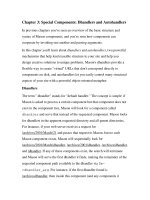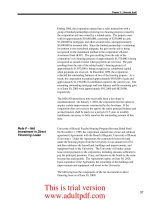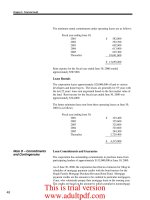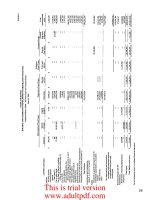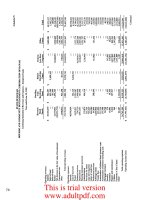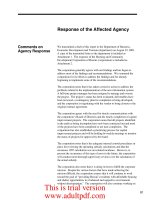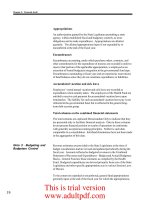Chapter 3: Financial Audit Receivables and Payables Activities between funds that are ppt
Bạn đang xem bản rút gọn của tài liệu. Xem và tải ngay bản đầy đủ của tài liệu tại đây (181.56 KB, 10 trang )
33
Chapter 3: Financial Audit
Receivables and Payables
Activities between funds that are representative of lending/borrowing
arrangements outstanding at the end of the fiscal year are referred to as
interfund receivables/interfund payables. Any residual balances
outstanding between the governmental activities and the business-type
activities are reported in the government-wide financial statements as
internal balances.
Use of Estimates
In preparing basic financial statements in conformity with GAAP,
management is required to make estimates and assumptions that affect
the reported amounts of assets and liabilities, the disclosure of contingent
assets and liabilities at the date of the financial statements, and the
reported amounts of revenues and expenses during the reporting period.
Actual results could differ from those estimates.
Nonimposed Employee Fringe Benefits
Payroll fringe benefit costs of the department’s employees are funded by
general fund appropriations and are assumed by the State, accordingly,
such costs are not charged to the department’s operating funds. These
costs, totaling $30,535,685, of which $7,334,000 was for retirement
benefits, have been reported as revenues and expenditures in the
department’s basic financial statements for the fiscal year ended June 30,
2003.
Payroll fringe benefit costs related to federally funded salaries are not
assumed by the State and are recorded as expenditures in the
department’s basic financial statements.
Revenue estimates are provided to the State Legislature at the time of
budget consideration and are revised and updated throughout the fiscal
year. Budgeted expenditures are derived primarily from acts of the State
Legislature and from other authorizations contained in the State
Constitution, the Hawaii Revised Statutes (HRS) and other
authorizations contained in other specific appropriation acts in various
Session Laws of Hawaii. To the extent not expended or encumbered,
general fund appropriations generally lapse at the end of the year for
which the appropriations were made. The State Legislature specifies the
lapse date and any other particular conditions relating to terminating the
authorization for other appropriations.
For budgeting purposes, the department’s budgetary fund structure and
accounting principles differ from those utilized to present the basic
financial statements in conformity with GAAP. Encumbrances represent
Note 2 – Budgeting and
Budgetary Control
This is trial version
www.adultpdf.com
34
Chapter 3: Financial Audit
executed but unperformed purchase orders or contracts. Encumbrances
are recorded as expenditures for budgetary purposes and as reservations
of fund balance for GAAP purposes. Since budgetary basis differs from
GAAP, budget and actual amounts in the accompanying Required
Supplementary Information – Budgetary Comparison Schedules are
presented on the budgetary basis. A reconciliation of the excess of
revenues over expenditures on a budgetary basis to the excess
(deficiency) of revenues over expenditures presented in conformity with
GAAP is set forth in the Note to Budgetary Comparison Schedules.
At June 30, 2003, the proprietary fund loans receivable consists of loans
to county governmental units for the water pollution control and drinking
water treatment programs. The loans are due in annual, semi-annual, or
quarterly payments, including interest at 1.55 percent to 3.02 percent,
commencing not later than one year after project completion or notice to
proceed. Final payment is due not later than 20 years after project
completion. Accrued interest receivable on the loans amounted to
approximately $1,555,825 at June 30, 2003.
The following is a schedule of principal payments due on loans for
projects completed or in progress as of June 30, 2003:
Year ending June 30:
2004 $ 11,233,023
2005 11,525,840
2006 11,807,261
2007 12,098,068
2008 12,396,571
Thereafter 114,618,713
$ 173,679,476
Note 3 – Loans
Receivable
This is trial version
www.adultpdf.com
35
Chapter 3: Financial Audit
Capital asset activity for the year ended June 30, 2003 was as follows:
Depreciation expense for the year ended June 30, 2003 was charged to
functions as follows:
Governmental activities
General administration $ 513,091
Environmental health 1,632,877
Behavioral health 1,598,868
Health resources 861,649
Total depreciation expense – governmental activities $ 4,606,485
Business-type activities:
Environmental health $ 73,434
Note 4 – Capital Assets
Beginning Ending
Balance Additions Deletions Balance
Governmental activities:
Capital assets not being depreciated:
Land $ 1,018,080 $ — $ — $ 1,018,080
Total capital assets not being depreciated 1,018,080 — — 1,018,080
Capital assets being depreciated:
Land improvements 1,862,927 — — 1,862,927
Building and improvements 126,113,479 — (276,000) 125,837,479
Furniture and equipment 12,298,031 930,456 (1,029,979) 12,198,508
Total capital assets being depreciated 140,274,437 930,456 (1,305,979) 139,898,914
Less accumulated depreciation:
Land improvements 1,475,755 115,023 — 1,590,778
Building and improvements 52,718,719 3,892,465 (276,000) 56,335,184
Furniture and equipment 10,515,309 598,997 (1,012,970) 10,101,336
Total accumulated depreciation 64,709,783 4,606,485 (1,288,970) 68,027,298
Total capital assets of governmental activities, net $ 76,582,734 $ (3,676,029) $ (17,009) $ 72,889,696
Business-type activities:
Capital assets being depreciated:
Equipment $ 459,907 $ 179,743 $ (46,188) $ 593,462
Less accumulated depreciation for equipment 214,667 73,434 (46,188) 241,913
Total capital assets of business-type activities, net $ 245,240 $ 106,309 $ — $ 351,549
This is trial version
www.adultpdf.com
36
Chapter 3: Financial Audit
Employees’ Retirement System
Plan Description
All eligible employees of the State are required by Chapter 88, HRS, to
become members of the Employees’ Retirement System of the State of
Hawaii (ERS), a cost-sharing multiple-employer public employee
retirement plan. The ERS provides retirement benefits as well as death
and disability benefits. The ERS issues a comprehensive annual
financial report that is available to the public. That report may be
obtained by writing to the ERS at 201 Merchant Street, Suite 1400,
Honolulu, Hawaii 96813.
The ERS consists of a contributory plan and a noncontributory plan.
Employees covered by Social Security on June 30, 1984 were given the
option of joining the noncontributory plan or remaining in the
contributory plan. All new employees hired after June 30, 1984, who are
covered by Social Security, are generally required to join the
noncontributory plan. Both plans provide a monthly retirement
allowance based on the employee’s age, years of credited service, and
average final compensation (AFC). The AFC is the average salary
earned during the five highest paid years of service, including the
payment of salary in lieu of vacation, if the employee became a member
prior to January 1, 1971. The AFC for members hired on or after this
date is based on the three highest paid years of service excluding the
payment of salary in lieu of vacation. Vesting requirements for the
contributory and noncontributory plans are five years and ten years,
respectively. All contributions, benefits, and eligibility requirements are
governed by Chapter 88, HRS.
Funding Policy
Most covered employees of the contributory plan are required to
contribute 7.8 percent of their salary. Police officers, firefighters,
investigators of the department of the prosecuting attorney and the
attorney general, narcotics enforcement investigators, and public safety
investigators are required to contribute 12.2 percent of their salary. The
actuarial cost or funding method used to calculate the total employer
contribution required is the entry age normal actuarial cost method.
Under this method, the total employer contributions to the ERS is
comprised of normal cost plus level annual payments required to
amortize the unfunded actuarial accrued liability over the closed period
ending June 30, 2029.
Post-Retirement Health Care and Life Insurance Benefits
In addition to providing pension benefits, the State provides certain
health care and life insurance benefits to all employees hired prior to
July 1, 1996 who retire from State employment on or after attaining age
62 with at least ten years of service or age 55 with at least 30 years of
Note 5 – Retirement
Benefits
This is trial version
www.adultpdf.com
37
Chapter 3: Financial Audit
service under the noncontributory plan and age 55 with at least 5 years of
service under the contributory plan. Retirees credited with at least 10
years of service excluding sick leave credit qualify for free medical
insurance premiums; however, retirees with less than 10 years must
assume a portion of the monthly premiums. All service-connected
disability retirees who retired after June 30, 1984, with less than 10 years
of service also qualify for free medical insurance premiums. Free life
insurance coverage for retirees and free dental coverage for dependents
under age 19 are also available. Retirees covered by the medical portion
of Medicare are eligible to receive a reimbursement of a portion of the
basic medical coverage premiums.
For employees hired after July 1, 1996 and who retire with fewer than 25
years of service, the State shall pay to a fund a monthly contribution
equal to one-half of the retired employee’s monthly Medicare or non-
Medicare premium for certain medical benefits for retired employees
with 10 or more years of service; and 75 percent of the retired
employee’s monthly Medicare or non-Medicare premium for retired
employees with at least 15 but fewer than 25 years of service.
For active employees, the employer’s contributions are based upon
negotiated collective bargaining agreements, and are funded by the State
as accrued.
Cost of Retirement Benefits
The department’s general fund share of the expense for pension and
post-retirement benefits for the year ended June 30, 2003, are paid from
the state general fund and approximate $7,334,000 (see Note 1(n)). The
department’s special revenue fund and proprietary fund share of the
pension and post-retirement benefits expense for the year ended June 30,
2003, was approximately $3,138,000 and $212,000, respectively, and are
included in the department’s basic financial statements.
The department leases various office facilities and equipment on a long-
term basis as provided for in the lease agreements. The following is a
schedule of minimum future rentals on noncancelable operating leases at
June 30, 2003:
Year ending June 30:
2004 $ 930,870
2005 852,080
2006 949,790
2007 444,680
2008 418,340
$ 3,595,760
Note 6 – Lease
Obligations
This is trial version
www.adultpdf.com
38
Chapter 3: Financial Audit
Total governmental activities rent expense for the year ended June 30,
2003 was $1,897,390.
Deferred Compensation
The State offers its employees a deferred compensation plan created in
accordance with Internal Revenue Code Section 457. The plan, available
to all state employees, permits employees to defer a portion of their
salary until future years. The deferred compensation is not available to
employees until termination, retirement, death, or unforeseeable
emergency.
All plan assets are held in a trust fund to protect them from claims of
general creditors. The State has no responsibility for loss due to the
investment or failure of investment of funds and assets in the plan, but
does have the duty of due care that would be required of an ordinary
prudent investor. Accordingly, the assets and liabilities of the State’s
deferred compensation plan are not reported in the accompanying basic
financial statements.
Litigation
The department is a party to various legal proceedings, most of which
normally occur in governmental operations. Although the department
and its counsel are unable to express opinions as to the outcome of the
litigation, it is their opinion that any potential liability arising there from,
will not have a material adverse effect on the financial position of the
department, because any judgments against the department are
judgments against the State, and would have to be paid by legislative
appropriation of the state general fund and not by the department.
Ceded Land
The Office of Hawaiian Affairs (OHA) and the State are presently in
litigation involving the State’s alleged failure to properly account for and
pay to OHA moneys due to OHA under the provisions of the Hawaii
State Constitution and Chapter 10, HRS, for use by the State of certain
ceded lands. As of June 30, 2003, the outcome of the lawsuit had not
been decided.
Note 7 – Commitments
and Contingencies
This is trial version
www.adultpdf.com
39
Chapter 3: Financial Audit
Note 8 – Transfers
For the year ended June 30, 2003, transfers by fund were as follows:
Transfers In Transfers Out
Governmental funds:
Tobacco settlement fund $ — $ 18,722,949
Nonmajor Funds 6,682,711 9,799,541
$ 6,682,711 $ 28,522,490
Proprietary funds:
Water pollution control
revolving fund $ 2,094,000 $ —
Drinking water treatment
revolving loan fund 1,551,000 —
$ 3,645,000 $ —
The tobacco settlement fund transferred $18,722,949 to the state general
fund and the Department of Budget and Finance pursuant to
Chapter 328L, HRS. Transfers out of nonmajor funds included
$3,645,000 transferred to the proprietary funds relating to the State’s
matching of federal funds received from the U.S. Environmental
Protection Agency. The remaining transfers in/out of nonmajor funds
were made to/from other State agencies to fund various programs and
services.
This is trial version
www.adultpdf.com
40
Chapter 3: Financial Audit
Exhibit 3.1
Governmental Business-t
y
pe
A
c
ti
v
iti
es
A
c
ti
v
iti
es
T
o
t
a
l
Current assets:
Cas
h
an
d
cas
h
equ
i
va
l
ents on
d
epos
i
t w
i
t
h
t
h
e
State of Hawa
ii
$
120,590,696
$
100,202,725
$
220,793,421
Receivables:
47,590 2,261,687 2,309,277
2,561,952 851,517 3,413,469
(
395,000
)
395,000 —
— 11,233,023 11,233,023
Total receivables 2,214,542 14,741,227 16,955,769
Total current assets 122,805,238 114,943,952 237,749,190
— 162,446,453 162,446,453
72,889,696 351,549 73,241,245
Total assets 195,694,934 277,741,954 473,436,888
11,650,441 — 11,650,441
6,449,596 49,082 6,498,678
Accrue
d
vacat
i
on, current port
i
on
(
Note 1
)
6,661,303 — 6,661,303
634,373 — 634,373
330,814 — 330,814
46,805 — 46,805
25,773,332 49,082 25,822,414
Accrued vacation, net of current portion (Note 1) 11,842,316 — 11,842,316
Total liabilities 37,615,648 49,082 37,664,730
72,889,696 351,549 73,241,245
Loans — 277,341,323 277,341,323
To
b
acco prevent
i
on an
d
contro
l
27,277,052 — 27,277,052
Cap
i
ta
l
pro
j
ects 1,406,017 — 1,406,017
Ot
h
er purposes 32,449,955 — 32,449,955
Unrestr
i
cte
d
24,056,566 — 24,056,566
Total net assets
$
158,079,286 $ 277,692,872 $ 435,772,158
See accompanying notes to basic financial statements.
Primary Government
DEPARTMENT OF HEALTH
STATE OF HAWAII
Statement of Net Assets
June 30, 2003
Assets
Accrued interest and loan fees (Note 3)
Due from federal government
Internal balances
Capital assets, net (Note 4)
Current maturities of loans receivables (Note 3)
Total current liabilities
Invested in capital assets
Loans receivable, net of current maturities (Note 3)
Accrued wages and employee benefits payable
Liabilities and Net Assets
Current liabilities:
Workers’ compensation liability (Note 1)
Restricted for:
Vouchers and contracts payable
Net assets:
Commitments and contingencies (Notes 5, 6, and 7)
Deferred income
Due to State General Fund
This is trial version
www.adultpdf.com
41
Chapter 3: Financial Audit
Exhibit 3.2
O
p
eratin
g
Char
g
es for
Grants and Governmental Business-t
yp
e
Ex
p
enses Services Contributions Activities Activities Total
Primary government:
Governmental activities:
General administration
$
24,935,698
$
325,164
$
8,638,481
$
(15,972,053)
$
—
$
(15,972,053)
Environmental health administration 36,287,269 5,893,051 8,388,703 (22,005,515)
—
(22,005,515)
Behavioral health services administration 192,769,198 1,973,307 13,136,150 (177,659,741)
—
(177,659,741)
Health resources administration 249,905,904 1,275,123 56,895,824 (191,734,957)
—
(191,734,957)
Total governmental activities 503,898,069 9,466,645 87,059,158 (407,372,266) — (407,372,266)
Business-type activities:
Environmental health loan programs 2,028,675 5,938,729 10,310,356
—
14,220,410 14,220,410
Total primary government $ 505,926,744 $ 15,405,374 $ 97,369,514 (407,372,266) 14,220,410 (393,151,856)
General revenues:
State general fund allotments 317,485,335
—
317,485,335
Nonimposed employee fringe benefits (Note 1) 30,535,685
—
30,535,685
Environmental response tax 1,562,115
—
1,562,115
Deposit beverage container fee 2,091,733
—
2,091,733
Advance glass disposal fee 3,066,777
—
3,066,777
Tobacco settlement funds 43,523,519
—
43,523,519
Other 94,837
—
94,837
Transfers (Note 8) (21,839,779) 3,645,000 (18,194,779)
Total general revenues and transfers 376,520,222 3,645,000 380,165,222
Change in net assets (30,852,044) 17,865,410 (12,986,634)
Net assets at July 1, 2002 188,931,330 259,827,462 448,758,792
Net assets at June 30, 2003 $ 158,079,286 $ 277,692,872 $ 435,772,158
See accompanying notes to basic financial statements.
Functions/Pro
g
rams
Pro
g
ram Revenues Primar
y
Government
Net (Expense) Revenue and Changes in Net Assets
DEPARTMENT OF HEALTH
STATE OF HAWAII
Statement of Activities
Year Ended June 30, 2003
This is trial version
www.adultpdf.com
42
Chapter 3: Financial Audit
Exh
i
b
i
t
3
.
3
Other Total
Tobacco
G
overnmental
G
overnmental
G
eneral
S
ettlement Funds Funds
Cash and cash equivalents $ 48,206,306 $ 28,033,175 $ 44,351,215 $ 120,590,696
Accrue
d
i
nterest rece
i
va
bl
e — — 47,590 47,590
Due
f
rom
f
e
d
era
l
government — — 2,561,952 2,561,952
Total assets $ 48,206,306 $ 28,033,175 $ 46,960,757 $ 123,200,238
Liabilities:
Vouchers and contracts payable
$
7,867,732
$
708,048
$
3,074,661
$
11,650,441
Accrue
d
wages an
d
emp
l
oyee
b
ene
fi
ts 4,874,110 48,075 1,527,411 6,449,596
De
f
erre
d
i
ncome — — 330,814 330,814
Due to ot
h
er
f
un
d
s — — 395,000 395,000
Due to State Genera
l
Fun
d
46,805 — — 46,805
Total liabilities 12,788,647 756,123 5,327,886 18,872,656
Fund balances:
Reserve
d
f
or encum
b
rances 39,492,554 10,455,938 28,255,839 78,204,331
Unreserve
d
, reporte
d
i
n:
Ma
j
or
f
un
d
s:
Genera
l
(
4,074,895
)
— —
(
4,074,895
)
To
b
acco sett
l
ement — 16,821,114 — 16,821,114
N
onmajor special revenue funds — — 13,377,032 13,377,032
Total fund balances 35,417,659 27,277,052 41,632,871 104,327,582
Total liabilities and fund balances $ 48,206,306 $ 28,033,175 $ 46,960,757 $ 123,200,238
See accompanying notes to basic financial statements.
Liabilities and Fund Balances
Assets
DEPARTMENT OF HEALTH
Balance Sheet - Governmental Funds
June 30, 2003
STATE OF HAWAII
This is trial version
www.adultpdf.com
